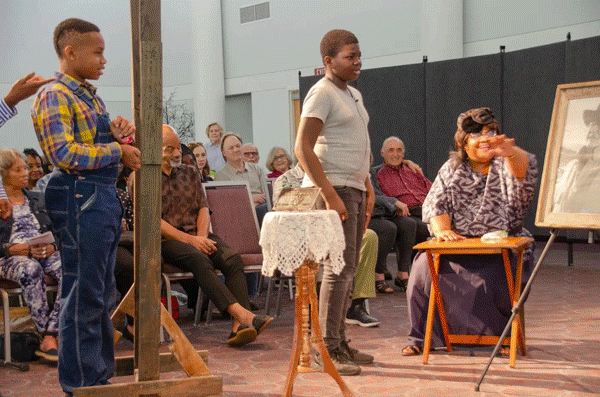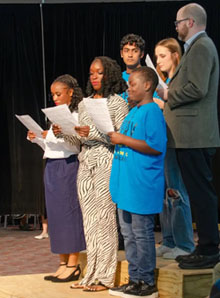“The Flats: Cradle of a Community,” is a musical drama that depicted the lives of African Americans in Garland in the 1930s – 1940s. The Flats was the area of the city where African Americans lived in that period. The neighborhood had homes, churches, stores and a school that taught children through the 8th grade. The Black children had to go to Dallas for high school.
The musical was Sunday, April 14, at the Atrium at the Granville Arts Center, which is where the “Garland Colored School” was situated.
The cast of “The Flats: Cradle of a Community,” which included all ages, was great.

Photos courtesy of Deborah Downes of Take to Heart Images
“We are hugely proud of our cast for many reasons, and you’ll see why, but one fact we need to note: this cast is a terrific representation of the diversity within the Garland Black community itself,” said Louis Moore, emcee of the play and president of Friends of Garland’s Historic Magic 11th Street.
The audience learned about numerous injustices that the Black population was forced to endure. A few of those concerned education. The books used at the Garland Colored School were hand-me-downs from the white children’s schools. Often, the books had been written in and pages were missing, making it difficult for the kids to learn. The students were also expected to be excited when it was announced that the Garland ISD was going to build them a new nine-room school building.
Other truths brought out include that although African Americans were allowed to shop at stores on the downtown square, they were not allowed to try on the clothing or return items that did not fit. They could not swim at the municipal pool or even attend Garland High School football games. They had to stand outside a fence and see what they could.
Beauty salons that served white people did not accept African American customers. However, the salons that primarily served Black women would allow white women to have their hair done.

Photos courtesy of Deborah Downes of Take to Heart Images
There were even hardships associated with seeing movies. According to information given by African Americans who grew up in The Flats in this period, the movie’s balcony was divided in half. The Black people had to sit on the left side and the white sat on the right, in addition to having the entire downstairs area. When there was a possibility that there might not be enough seats, Black people who had paid and were already seated, were made to leave.
These are just a few examples of discriminatory behaviors portrayed in the play.
Kay Moore wrote the drama, along with most of the music, and it was sponsored by Friends of Garland’s Historic Magic 11th Street. It was funded in part by a grant from the Garland Cultural Arts Commission and the city of Garland Cultural Arts Division. Garland Housing Finance Corporation funded the equipment for the sets.
The play was dedicated to Carol Montgomery, a long-time educator, dedicated volunteer, civic leader, founding member of the Garland Unit of the NAACP and much more.
In addition, a number of Black Garland residents were honored for various contributions and accomplishments at the end of the play. These included elected state and city officials, educators, military members, judges and more.


